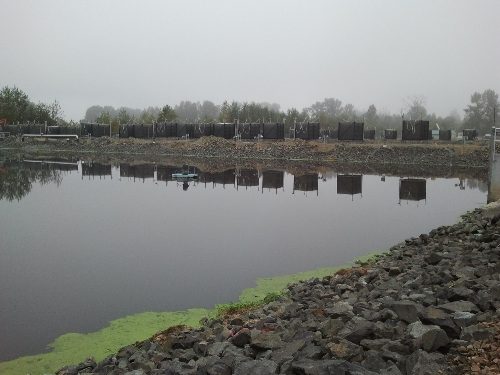The Snohomish WWTP is a 1.2 MGD plant consisting of four aerated lagoon cells located approximately 30 miles north of Seattle where heavy rainfall events are common. As a result, maximum month daily flows can peak at up to 7.9 MGD, decreasing biological treatment and in extreme cases, causing the slow growing nitrifiers to wash out.

Figure 1. Snohomish WWTP Process Flow
The Washington DOE issued a new permit in 2006, which made it almost impossible for the effluent limits to be consistently met. Total maximum daily load limits (TMDL) were established on cBOD and ammonia-N at 93 ppd and 99 ppd, respectively, for July through October and 58 ppd and 29 ppd for the rest of the year. The combination of the high flow events and the new permit caused 60 daily limit violations and 18 monthly average limit violations between August 2006 and August 2010.
In 2009, a Conveyance Order was issued with a long-term plan of shutting down the plant and sending wastewater from Snohomish to a regional WWTP. However, near-term improvements were also mandated in order to eliminate the effluent CBOD5 and ammonia violations. Another objective of the near term improvements was limiting the utility rate increase seen by its citizens and saving funds for the long-term improvement plan.
Working in conjunction with Kennedy/Jenks Consultants, the City evaluated a number of integrated fixed-film media solutions for the near-term improvements, including both fixed and moving media systems. Ultimately, Entex’s WebitatTM submerged fixed-film (SFF) system was chosen. In March 2012, the City began construction on a facility upgrade which included retrofitting each of the last three partially mixed lagoons with 18 SFF media modules. Each Webitat module was equipped with an integral diffuser system which allows for a thin, healthy biomass, enhanced mixing, and DO control.

Figure 2. Plan View of the Submerged Fixed-film System
Since the effluent limits for cBOD5 and ammonia vary by season, the Webitat system was designed to operate in one of two modes. From July through October, the Webitats run in full aeration mode. During the remainder of the year when nitrification isn’t required, the Webitat units cycle on and off, resulting in considerable energy savings. In addition, since the plant has been able to create a stable NOB population, they have been able to shut off their surface aerators in Lagoons 2, 3 and 4.
Upon installing the SFF Webitat system in 2012, the plant saw dramatic improvement. Figure 3 below shows the ammonia performance immediately after conversion.

Figure 3. Effluent Ammonia after SFF System Upgrade
So how does the plant perform after 5 years of operation? Figures 4 and 5 show that the cBOD5 and ammonia-N removal are consistent with those observed after installation despite increased plant loadings over the years.

Figure 4. cBOD5 Removal after 5 Years

Figure 5. Ammonia-N Removal after 5 Years
Due to the strong and consistent performance of Entex’s Webitat system, the plan to close the Snohomish WWTP has been canceled resulting in a significant savings for the utility and its customers! Contact Entex today for your treatment upgrade (https://entexinc.com/request-a-design/).
